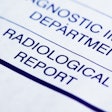The need for clinical proof that AI boost outcomes, workflow, and business metrics continues to grow, and the lack of proven successes appears to be contributing to the slow deployment of radiology AI. But will significant new evidence be presented at ECR 2024, which begins on Wednesday?
In a Q&A interview, Prof. Erik Ranschaert, PhD, past president of the European Society of Medical Imaging Informatics (EuSoMII) and visiting professor at Ghent University in Belgium, looks ahead to the congress and comments on the recent statement made by the ESR, RSNA, and other societies.
Q: Which AI sessions are you particularly looking forward to at ECR and why?
A: I will attend as many AI-related sessions as possible -- certainly those on the new developments related to multimodal foundation models, which is a turning point in the AI revolution we are experiencing. Undoubtedly one of the best sessions will be the E3 courses about Sustainable Technological Innovations on Thursday morning, when I will speak about "AI and x-ray: the perfect wedding" (E³ 819 - X-ray: still alive? February 29, 09:30 - 11:00 CET). I'm also looking forward to attending lectures about sustainability and about clinical validation and monitoring of AI solutions.
Q: The ESR, RSNA, and 3 other societies issued a statement about AI on 22 January. Do you think this statement was important? If so, why?
A: Yes, it was an important statement and a very strong one since all those societies were able to formulate a joint position. The fact that they did so is almost unprecedented, the previous one being more focused on ethical values in the development of AI. It shows that there is a growing awareness about the changes that are occurring in our profession, and simultaneously that there is still quite some uncertainty and even fear for the unthoughtful use of such solutions. This probably also has to do with the speed by which this technology is evolving. All these changes require a solid framework, which is the main reason for this statement.
Q: Consolidation seems to be the buzzword in radiology AI right now. Why do you think that is? Do you expect more acquisitions and mergers of AI companies in 2024?
A: The market is changing rapidly, and it is a very competitive and difficult marketplace. The smaller players are disappearing or slowly integrating with the larger and more capital-rich players. This has much to do with the slowness with which investments are typically made in healthcare, especially in Europe, and the current prevalent lack of government financial support.
So yes, I expect this trend is set to continue for now. Separating the wheat from the chaff, you might say...
Q: Reimbursement seems to be another hot topic. Has it become a serious obstacle to the implementation of AI? How can radiology overcome this obstacle? Who do you think should pay for AI?
A: Many radiologists are still not aware of the potential advantages. The existing distrust can be reduced in many cases by having radiologists work with an AI solution in their practice. Another major barrier has been and continues to be funding and the difficulty of finding a business case that has a clear return on investment attached to it. A balance must also be sought between quality improvement and production increase or workflow improvement, and this is not always easy. In Europe, where most healthcare systems are based on socialized healthcare, I believe it is also the government's task to make a constructive contribution here, so that the applications can be enabled on a larger scale.
Q: What else must be done to speed up the implementation of radiology AI?
A: The recent development of large language models (LLMs) and multimodal foundation models will give a new boost to the development of AI solutions that can be deployed in clinical practice, the main advantage being the fact that they are able to be trained with a large variety of data. This will also open the door to the further development of personalized medicine (precision medicine) Furthermore, it will also become possible to develop and implement AI applications much better tailored to the users and the necessary use cases.
Another important issue is the need to monitor the AI applications in clinical practice (surveillance): for this it is necessary to develop the necessary tools and platforms, where it is not only possible to monitor the performance of algorithms on the studies performed, but also to evaluate the effects of AI on diagnostics and therapy in patients (outcome measurement). Generating evidence with "real world" data and outcomes will increase the reliability of AI, which is needed for more widespread adoption or these products
Q: Outside of radiology, you keep very active on your bike, climbing mountains, etc. What are your main goals in 2024?
A: My main goal now is to run the Rome Marathon in March. This will be an important part of my birthday celebrations. My son invited me to join him in the race, which I consider an unforgettable challenge. Training is going well, and I must honestly say that I am really looking forward to it.
Editor's note: Please make sure you also check out Road to ECR 2024: AI Preview, our guide to key sessions and technology trends for Europe's premier radiology congress, which begins in Vienna on 28 February.






